Today’s article on the Marketeer will be brought to you by the number 4,096.
That’s about how many different individual contexts content marketers need to address if they want to produce the right content for the right customer at the right time.
Seems high, doesn’t it?
But it’s actually fairly conservative if we break it down.
We start with six different criteria for determining who the customer is and where they are on their path to purchase:
- Channel: the channel with which they’re interacting with the vendor
- Persona: the personal profile of the customer contact
- Segment: the profile of the customer company
- Buying Stage: where the customer is on their journey
- Geography: where the customer is physically located
- Product: what product is the best offer for a customer
Then we figure there is an average four different options within each of these criteria:
Channel:
- Written content (blogs, case studies, white papers)
- Social media
- Sales team
- Video
Persona:
- Mary the Marketer
- Charli the CIO
- Rajesh the Researcher
- Daven the Director
Segment:
- Stable small business
- High growth startup
- Global enterprise
- One-person team
Buying Stage:
- Awareness
- Consideration
- Purchase
- Retention
Geography:
- North America
- Europe
- East Asia
- Australia/New Zealand
Product:
- Basic product
- Product for teams
- Extension for more functionality
- Customized version
In order to provide content that’s tailored to every single possible variation of these six criteria and four options, we’d need 4,096 content variations.
That number may still seem scary, but don’t worry — you don’t actually have to produce 4,096 different pieces of content.
In fact, you definitely shouldn’t do that, because it would be enormously stressful and a waste of your time. It’s time to work smarter, not harder on our content production.
By coming up with a strategic approach to content reuse, and then executing on it using Agile marketing iterations, we can produce better content that converts more efficiently, without drowning under thousands of deliverables.
The Trouble With Silos
To make this “more from less” approach work, we first have to move away from the rigid silos in which many teams create content.
Right now many of us are producing lots and lots of content, but we lack communication among teams. Content is misaligned, and there are gaps in coverage.
What’s more, misalignment and poor communication produce an enormous amount of waste, particularly on B2B content teams.
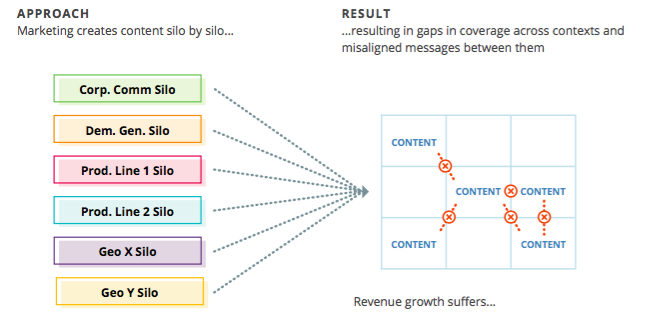
SiriusDecisions suggest that 60-70% of content produced by B2B companies goes unused, while Corporate Visions suggest it is even higher (90%).
But, if we replace these disparate silos with an overarching content operation that governs content production, the above arrangement flips:
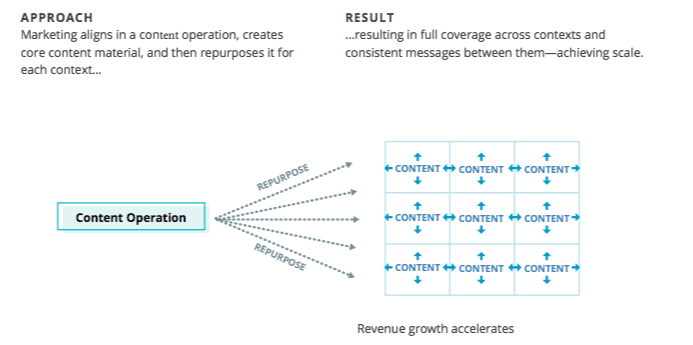
A content operation manages strategy, governance, process, and reuse, streamlining and systematizing the production of content. There is now a single point of origin for content within an organization, which slowly disintegrates the walls between content teams.
By opening up the lines of communication in this way, opportunities for repurposing become more apparent, and rework becomes less common.
Content is more likely to be used, and teams aren’t duplicating one another’s efforts. Siloed teams will always struggle with repurposing content effectively.
Executing an Agile Reuse Strategy
Now that communication and collaboration have been taken care of, it’s time to get down to doing the work of making adaptable content.
By taking an Agile approach to this process, we can accelerate the delivery timeline for many of the components, allowing the content team to prove value earlier while adapting to the data they collect from initial releases.
Content Reuse Walkthrough
We’ll use a fictional content team to illustrate how this process can work. Here’s a quick look at one phase of a repurposing effort, which targets a single persona, product, buying stage, and language/region:
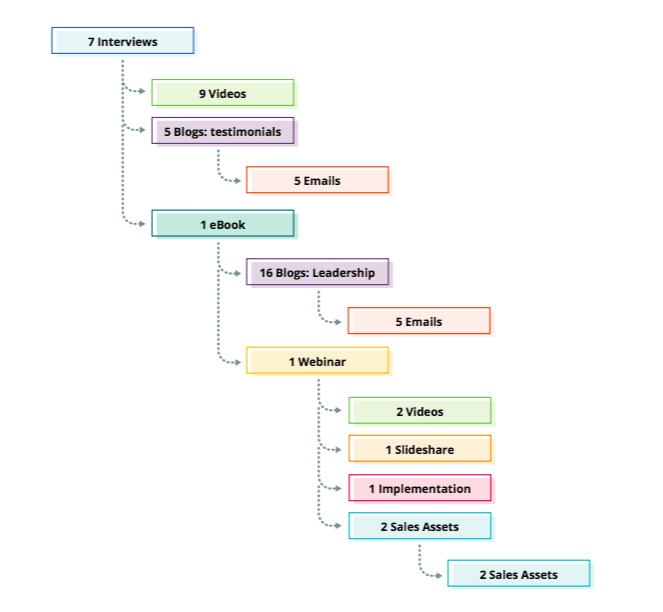
The team begins their initiative by conducting seven video interviews, five with customers and two with industry experts. These interviews will be compiled into a large ebook, the central asset of the entire campaign.
The concepts and graphics of the ebook become the Powerpoint slides and script for a webinar, and its chapters can be easily adapted into blog posts. In its turn, the webinar’s slides can be adapted to a Slideshare presentation, while its recording becomes two standalone videos.
Each interview includes some testimonial-style sections as well as more general best-practices commentary, allowing the team to turn them into product-focused case studies as well as less sales-driven blog content.
Every blog post and testimonial becomes their own email, summarizing the message and providing a link to the full article or asset.
Once this first large phase has been completed, the team can then adapt many of its assets to fit different personas, buying stages, products, and regions without needing to start from scratch every time.
Traditional Content Repurposing
A traditional team could very likely take several quarters or a year to complete a full repurposing campaign. They come close to hitting all the relevant contexts for their audience, but it takes them a long time to get there.
For example, here’s a 14-month timeline for this kind of initiative:
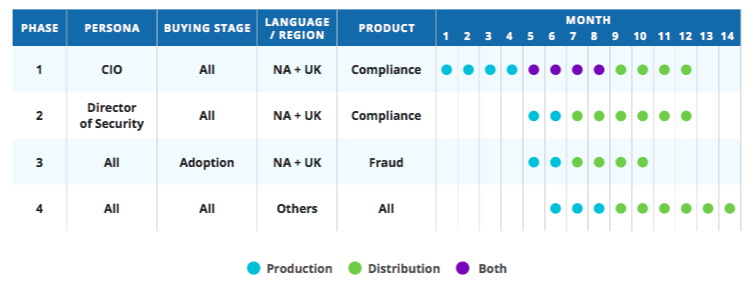
As a reminder, here is all the repurposing work the team will tackle in Phase 1 (the subsequent phases are less hefty):
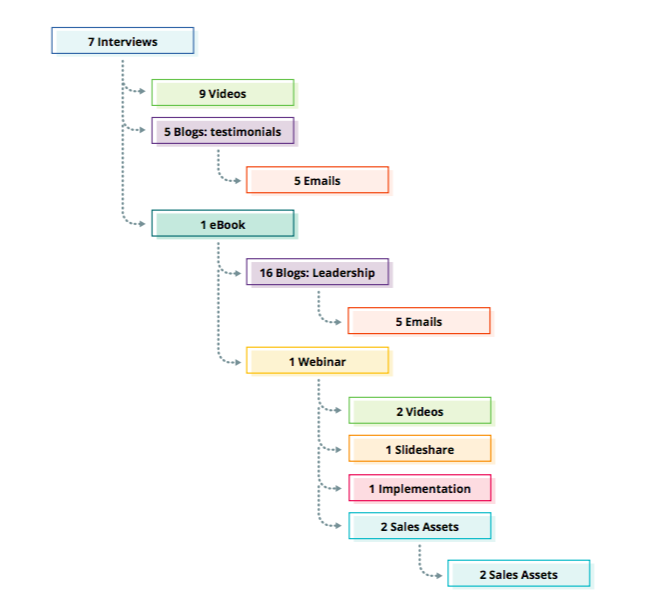
You can see that this flows in a very waterfall-like fashion; there are many dependencies among the pieces that require one stage to be fully complete before the next can begin. In the first chart, you’ll see that there are four months of production work before anything is distributed.
In the always-on, real-time world of content consumption, that’s a pretty long time to go without communicating with an audience.
So let’s take a look at how we might adjust this repurposing initiative to run on a more Agile schedule.
Agile Content Repurposing
Happily, getting more Agile about repurposing requires only slight adjustments to how we structure the initiative. These small changes help the content team reduce lead time and get content into the market faster, which maintains a connection with the audience and proves the viability of the campaign much sooner.
(I want to note that in this context I’m using “Agile” in a very general sense. I’m not referring to a particular methodology, because each content team will need to choose how best to execute within their own situation. You can find more on Agile methodologies and how to choose among them here.)
Agile teams value many small experiments over a few large bets, a philosophy that lines up nicely with this repurposing model. Recall SiriusDecisons’ admonition that we “consolidate [our] marketing efforts into a smaller number of integrated campaigns.”
Smaller Content Campaigns
So to repurpose content in a more Agile way, we want to release smaller chunks over time rather than wait until we accumulate a huge amount of content.
For example, we could release a single blog post and video as soon as they are done, rather than wait for the completion all seven interviews. Each blog post/video combo could have its own iteration.
Releasing these smaller pieces creates learning opportunities that can help the team produce better results over time.
They might find out the four-minute video they released first had far lower conversions than the two-minute version they put out later. Now they can apply that lesson to future content, as well as return and reiterate their past work to make it more effective.
An Agile content team releases work more like this:
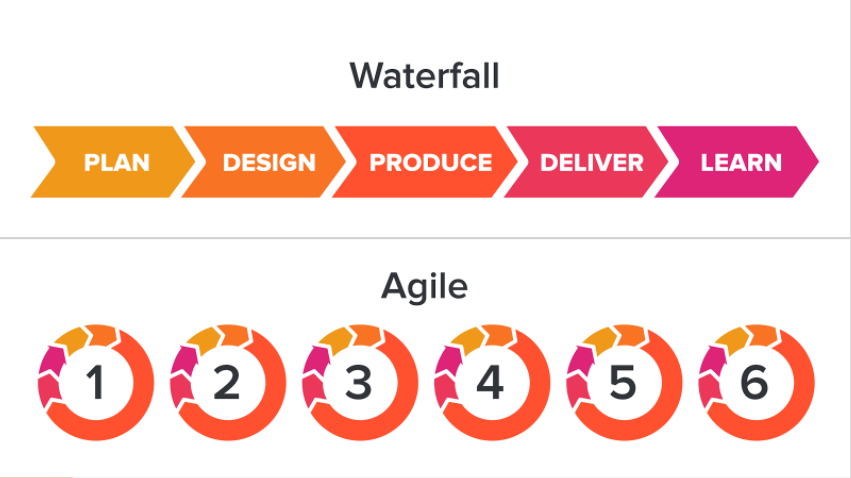
Systematic Review of Content Performance
Finally, Agile content teams set aside time at the end of each iteration to deliberately review the performance of past content.
What’s working? What’s not? What have we learned about our audience? These are all things that an Agile content team asks themselves regularly, even if they don’t like the answers.
During a repurposing initiative, an Agile team would also spend time discussing the repurposing process during their retrospectives so the approach itself could be continuously improved over time.
Finally, Agile content teams review how well their execution is mapping to the long-term objectives for their department and their organization. To do that, a long-range repurposing plan is necessary.
Being Agile is not an excuse to run off and start creating content without an idea of why you’re doing it. You still need a larger goal, like a repurposing initiative, to act as the team’s North star.


